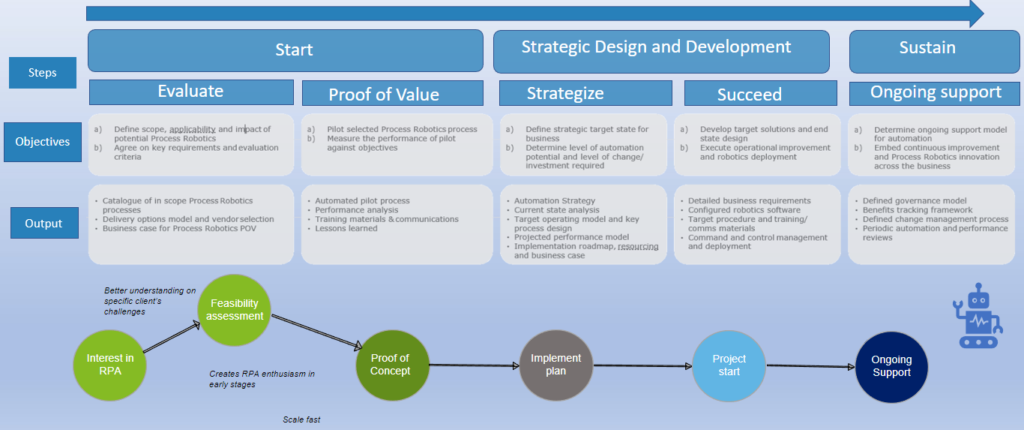
A “How to” Guide for a RPA implementation Roadmap
As more organization adopt automation today, getting started with a right strategy is important for the continued success of your RPA journey. A simple but effective strategy is sufficient to get you started before you get into more features of automation, where in you are adding Machine Language and Artificial Intelligence into the mix. However for the sake of simplicity, we are limiting ourselves to Robotic Process Automation
There are three key stages and five steps under these stages. Let us define them
- Start Stage
- Design and Development
- Sustain
These are then subdivided into five steps which are as follows
- Evaluate
- Show Proof of Value
- Strategize
- Succeed
- Ongoing Support and Maintenance
Once you have decided the stages and steps, you need to define the objectives and their outcomes.
This is encapsulated in the diagram below, which lists out the entire process.

As you can see in the diagram, the start process though looks easy, is difficult to start. For this you need to buy into the concept of RPA within your organization and have a strong set of evangelists and stakeholders who have the will to succeed. This is done by creating an interest in RPA and the potential benefits to the individual and the organization as a whole. Make your employees part of the evaluation process, getting their buy-in by involvement and the potential savings in both time, effort and overall saving to the organization.
After they get involved in the evaluation process, work on the Proof of Value. Select a simple pilot to demonstrate the capabilities and which has a high degree of success. Like employee on-boarding or invoice-consolidation. This is demonstrating the proof of concept.
Next steps are the Design and development, where your strategy can help you in success, where you implement the proof of concept into a working implement plan. Roll out the implementation to your organization – showcase and celebrate the success. Once the implementation succeeds, your organization can start to think of various ways to implement other processes. On-going support and maintenance is now part of your regular operations.
Well, this is a start for your organization, who are planning to get into RPA. Do it before it is too late!
Authored by Vijay Chander – 2022

